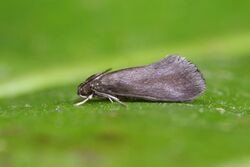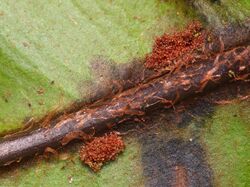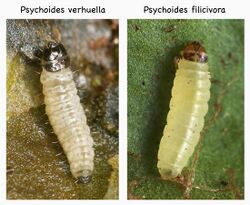Biology:Psychoides verhuella
| Psychoides verhuella | |
|---|---|

| |
| Scientific classification | |
| Kingdom: | Animalia
|
| Phylum: | |
| Class: | |
| Order: | |
| Family: | |
| Genus: | |
| Species: | P. vrhuellai
|
| Binomial name | |
| Psychoides verhuella Bruand, 1853
| |
Psychoides verhuella is a moth of the family Tineidae found in Europe. It was first described in 1853, by Charles Théophile Bruand d'Uzelle from a specimen from Besançon, France. It is the type species of the genus Psychoides, also raised by Charles Bruand in 1853.[1] The larvae feed on ferns.
Life cycle
Larva
Larvae feed from August to June, initially in a whitish mine in the frond, and in the spring they leave the mine and burrow into a sorus, feeding on the sporangia. They later form a loose, portable case from empty sporangia and when fully grown in May the case resembles a misplaced sorus, especially on hart's-tongue fern (Asplenium scolopendrium). The larva is yellowish white with a brownish dorsa line and has a black head and black prothoracic plate.[2]
The following ferns have been recorded as food plants,[3][4]
- rustyback (Asplenium ceterach)
- wall-rue (Asplenium ruta-muraria)
- hart's-tongue fern (Asplenium scolopendrium)
- maidenhair spleenwort (Asplenium trichomanes)
- bracken (Pteridium aquilinum)
Larva of another moth, Psychoides filicivora also feed on ferns. It has a pale-brown head and a pale-brown posterial margin, which has a split in the middle, compared with the black head and prothoracic plate of Psychoides verhuella.[5][6]
Pupa
In a larval case, which is often against the midrib of the food plant.[4] Can be found in May and June.[7]
Imago
Single brooded, the moth flies in June and July, in early morning and late afternoon sunshine. Occasionally comes to light.[8] The grey to dark grey monochrome forewings have a violet reflection and lack the white tornal spot of Psychoides filicivora. The antennae are wire-shaped and just over half as long as the front wings.
Distribution
Found in Europe, this species has been recorded from the following countries and regions; Austria, Belgium, Channel Islands, Czech Republic, Germany , Great Britain (local distribution), Hungary, Ireland, Poland and Romania.[9]
Etymology
Psychoides was raised by Charles Braund in 1853 and comes from psukhē – of the soul, i.e. a moth of the family Psychidae and eidos – form, that is from the similarity of this species to moths of the Psychidae. The specific name verhuella is in honour of the mid-19th century Dutch entomologist, Q M R Verhuell.[10]
References
- ↑ Pitkin, Brian; Jenkins, Paul (November 5, 2004). "Psychoides Bruand, 1853". Natural History Museum, London. https://www.nhm.ac.uk/our-science/data/butmoth/search/GenusDetails.dsml?NUMBER=24973.0. Retrieved 24 December 2021.
- ↑ Pelham-Clinton, p. 159
- ↑ "12.047 Psychoides verhuella Bruand, 1853". http://www.leafmines.co.uk/html/Lepidoptera/P.verhuella.htm. Retrieved 29 October 2019.
- ↑ 4.0 4.1 Ellis, W N. "Psychoides verhuella Bruand, 1853 hart's-tongue smut". https://bladmineerders.nl/parasites/animalia/arthropoda/insecta/lepidoptera/ditrysia/tineoidea/tineidae/teichobiinae/psychoides/psychoides-verhuella/. Retrieved 24 December 2021.
- ↑ Pelham-Clinton, p. 160
- ↑ Reinhard Gaedike, 2019 Tineidae II : Myrmecozelinae, Perissomasticinae, Tineinae, Hieroxestinae, Teichobiinae and Stathmopolitinae Microlepidoptera of Europe, vol. 9. Leiden : Brill
- ↑ Kimber, Ian. "12.047 BF199 Psychoides verhuella Bruand, 1853". https://ukmoths.org.uk/species/psychoides-verhuella/. Retrieved 29 October 2019.
- ↑ Sterling, Paul; Parsons, Mark; Lewington, Richard (2012). Field Guide to the Micro Moths of Great Britain and Ireland. Gillingham, Dorset: British Wildlife. p. 78. ISBN 978-0-9564902-1-6.
- ↑ "Psychoides verhuella Bruand, 1853". https://fauna-eu.org/cdm_dataportal/taxon/fe05a890-da57-4b82-83bb-5913dcf098ac.
- ↑ Emmet, A Maitland (1991). The Scientific Names of the British Lepidoptera. Their history and meaning. Colchester: Harley Books. p. 56. ISBN 0-946589-35-6.
Bibliography
- Pelham-Clinton, E. C. (1985). "Tiniedae". in Heath, John. The Moths and Butterflies of Great Britain and Ireland. 2. Colchester: Harley Books. pp. 152–208. ISBN 0-946589-19-4.
External links
Wikidata ☰ Q11662245 entry
 |



